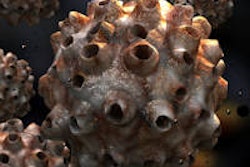
Spouses and long-term partners of patients with human papillomavirus (HPV)-related oral cancers appear to have no increased risk of oral HPV infections, according to a study by U.S. researchers. Their findings are outlined in the Journal of Clinical Oncology (April 28, 2014).
The incidence of HPV-positive oropharyngeal squamous cell cancer (HPV-OPC) has increased dramatically over the past three decades several studies show, which also indicate that oral HPV infection is the principal risk factor for HPV-OPC.
Sexual behavior is consistently associated with oral HPV infection, and many studies have found that people who have performed oral sex on a higher number of recent or lifetime partners have increased odds of developing oral HPV.

Because many HPV-OPC patients and their partners are worried about HPV transmission and partners' cancer risk, the researchers, led by Gypsyamber D'Souza, PhD, MPH, evaluated the oral HPV prevalence among such couples to better understand the risks. The study is the first large one to examine oral HPV infection among patients with HPV-caused oropharyngeal cancer and their partners.
Patients were primarily men (90%), had performed oral sex (97%), and were never smokers (51%), with a median age of 56 years. Most patients had a tonsil (48%) or base of tongue (40%) subsite. Four patients (2.4%) had metastatic disease at diagnosis. Most patients had testing documenting both HPV and p16 positivity in their tumors (67%).
The study included 164 patients with HPV-OPC; 93 (57%) had enrolled spouses/partners. Patients without enrolled partners were more likely to report multiple oral sexual partners in the past year (15.8% versus 5.8%; p = 0.001).
Partners were self-identified by patients as a person with whom they had been sexually active for two or more years. Partners were primarily women (94%), had performed oral sex (98%), and were never smokers (57%), with a median age of 53 years. Overall, oncogenic oral HPV prevalence among the 87 female partners was similar to that observed in the general population (1.2% versus 1.3%).
Participants were enrolled between October 2009 and May 2013 in head and neck cancer clinics at four study sites: Johns Hopkins Hospital in Baltimore, Mount Sinai Medical System in New York City; Dana-Farber Cancer Institute in Boston, and Oregon Health and Science University in Portland, OR.
Oral HPV DNA was collected through a 30-second mouth rinse and gargle at diagnosis and again one year later. The oral rinse samples were tested for 36 different subtypes of HPV, including HPV16, the type responsible for most HPV-OPC cases, as well as a variety of other cancers.
HPV16 E6 and E7 antibodies were significantly more common among patients than partners or healthy volunteers (each p < 0.001). Most patients and partners reported no personal cancer history and no known history of HPV-positive cancer in their current or former partners. Several HPV-OPC patients reported a previous partner who had been diagnosed with an HPV-positive cancer, including invasive cervical cancer (n = 3; 2.0%), oropharyngeal cancer (n = 2; 1.4%), and anal cancer (n = 1; 0.7%). One enrolled partner had a previous husband who died as a result of oropharyngeal cancer (before meeting her current partner, who also developed HPV-OPC).
Although most patients had no history of previous HPV-positive cancer, several had a previous or current partner with a history of cervical dysplasia or invasive cervical cancer. This is consistent with transmission of HPV to the oropharynx when performing oral sex on a partner with an oncogenic genital HPV infection, the study authors noted. Therefore, cervical HPV and Pap testing for female partners of patients with HPV-OPC is appropriate at the time of diagnosis of HPV-OPC, followed by routine Pap screening consistent with general screening recommendations for all women, the researchers noted.
Recent research suggests that husbands of women with cervical cancer have approximately a twofold increased risk of tonsillar cancer, supporting oral HPV transmission by performing oral sex (European Journal of Cancer Prevention, December 2000, Vol. 9:6, pp. 433-437).
Results
Although all patients with HPV-OPC had either oncogenic HPV and/or p16 detected in their tumors, only 61% had oncogenic HPV DNA detected in their oral rinses, similar to other studies that have suggested moderate sensitivity and low specificity of oral HPV DNA detection for HPV-OPC.
Because HPV is often integrated into the tumor DNA of these patients, much of the HPV DNA detected in oral rinses of patients may represent small DNA strands sloughed off from the tumor without the viral capsid and thus not infectious, the researchers said.
To further explore partners' risk of HPV-related cancer, the study measured HPV16 E6- and E7-specific antibodies, but no E6 or E7 antibodies were found in partners.
Conclusion
"Patients with HPV-positive oropharyngeal cancers and their partners often worry about oral HPV transmission and wonder about the cancer risk for their partner. These findings provide assurance that the prevalence of oral HPV infections is not increased among long-term partners and their risk of HPV-OPC remains low," said lead study author Gypsyamber D'Souza, PhD, MPH, an associate professor of epidemiology at Johns Hopkins Bloomberg School of Public Health. "Couples who have been together for several years have likely already shared whatever infections they have and no changes in their physical intimacy are needed."
The study demonstrates that most partners of patients with HPV-OPC do not have any detectable oral HPV DNA, suggesting either that oral-oral transmission (i.e., kissing) is rare and/or that most partners effectively clear any active infections to which they are exposed, the researchers concluded. Indeed, oncogenic oral HPV prevalence in partners in this study was similar to that in the general population of the same age, the study authors found.
The prevalence of both oral HPV16 DNA detection and HPV16 oncogene antibodies was rare among partners, suggesting their own risk of HPV-OPC remains low, the researchers concluded.
However, given the moderate sensitivity of oral HPV16 DNA detection demonstrated in patients (61% had oncogenic oral HPV detected), the presence of undetected or quiescent infection in partners cannot be excluded, they noted.



















